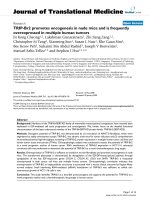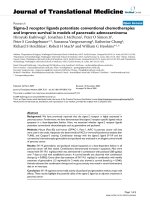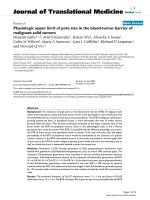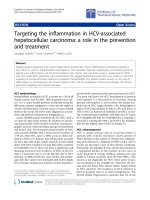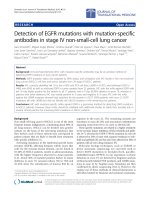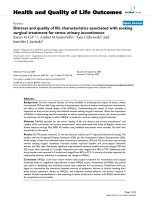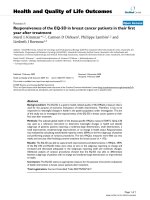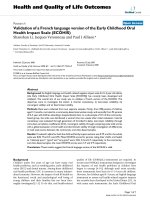Báo cáo hóa học: " Periodically Aligned Si Nanopillar Arrays as Efficient Antireflection Layers for Solar Cell Applications" ppt
Bạn đang xem bản rút gọn của tài liệu. Xem và tải ngay bản đầy đủ của tài liệu tại đây (377.85 KB, 6 trang )
NANO EXPRESS
Periodically Aligned Si Nanopillar Arrays as Efficient
Antireflection Layers for Solar Cell Applications
Xiaocheng Li
•
Junshuai Li
•
Ting Chen
•
Beng Kang Tay
•
Jianxiong Wang
•
Hongyu Yu
Received: 24 May 2010 / Accepted: 13 July 2010 / Published online: 28 July 2010
Ó The Author(s) 2010. This article is published with open access at Springerlink.com
Abstract Periodically aligned Si nanopillar (PASiNP)
arrays were fabricated on Si substrate via a silver-catalyzed
chemical etching process using the diameter-reduced
polystyrene spheres as mask. The typical sub-wavelength
structure of PASiNP arrays had excellent antireflection
property with a low reflection loss of 2.84% for incident
light within the wavelength range of 200–1,000 nm. The
solar cell incorporated with the PASiNP arrays exhibited a
power conversion efficiency (PCE) of *9.24% with a
short circuit current density (J
SC
)of*29.5 mA/cm
2
without using any extra surface passivation technique. The
high PCE of PASiNP array-based solar cell was attributed
to the excellent antireflection property of the special peri-
odical Si nanostructure.
Keywords Si nanopillar arrays Á Antireflection Á
Periodicity Á Solar cell Á Chemical etching
Introduction
Climate change, energy crisis and increasing monetary cost
arisen from the nonrenewable fossil fuels have attracted
extensive broad public attentions. The demands for
developing renewable clean energy resources have been
greatly increased in recent years [1, 2]. Among the various
energy projects in progress, photovoltaic (PV) is an almost
maintenance-free and truly renewable clean energy and is
considered as the most promising candidate for future
energy resources [3, 4]. Although many Si-based PV
devices have been developed during the past decades,
single-crystal Si wafer–based PV modules still show the
highest efficiency. However, more than 30% of incident
light is reflected back due to the high reflective index of Si,
which greatly reduces the PCE of the photovoltaic device.
For traditional Si wafer–based solar cells, the pyramidal or
inverted pyramidal structures were generally constructed
on Si surface to reduce the reflection loss for incident light
[5, 6]. Extra single-layer antireflection coating (SLARC) or
double-layer antireflection coating (DLACR), such as
Si
3
N
4
, MgF
2
and Si
3
N
4
/MgF
2
DLACR, was also needed to
further suppress the reflection loss [7]. Unfortunately, these
complex processes often make the rigorous requirements
for experimental condition and limit the practical applica-
tion of Si-based solar cells.
Recent studies on the optical and electrical characteris-
tics of Si nanostructures, including Si nonowires (SiNWs)
[8–12], Si nanopillars (SiNPs) [13] and Si nanocones/Si
nanotips (SiNCs/SiNTs) [14–16], demonstrate their prom-
ising applications in solar cell. These typical structures
involve the utilization of SiNWs/NPs/NTs that are long
enough to absorb most of incident light. Meanwhile, their
small diameters provide a short collection length for
excited carriers in a direction normal to the light absorp-
tion, even for relatively impure absorber materials [13].
Theoretical studies have indicated that PASiNP or
PASiNW arrays are beneficial for light reflection sup-
pression than the disordered ones [12, 16, 17]. Inspired by
these promising applications, many methods have been
developed to synthesize the SiNW and PASiNP arrays. In
these methods, electroless chemical etching is a simple
method to fabricate large-area SiNWs/NPs arrays without
using any special equipment [18–22]. However, this wet
etching process is hard to precisely control the position and
X. Li (&) Á J. Li Á T. Chen Á B. K. Tay Á J. Wang Á H. Yu
School of Electrical and Electronic Engineering, Nanyang
Technological University, 50 Nanyang Avenue,
Singapore 639798, Singapore
e-mail:
123
Nanoscale Res Lett (2010) 5:1721–1726
DOI 10.1007/s11671-010-9701-3
diameter of SiNWs, thus producing the disordered SiNWs
bundles and limiting their applications in solar cells. It is
worth mentioning that the reports on photovoltaic appli-
cations utilized highly ordered NWs/NPs arrays are still
rare [22].
In this study, a simple floating–transferring technique
was adopted to create large-scale PS sphere monolayer
without using any special equipment [23]. Combined with
a dry catalyst deposition as well as the previous wet
chemical etching process, large-area PASiNP arrays were
fabricated on Si surface using the diameter-reduced PS
spheres as mask. Due to their typical sub-wavelength
structure, the PASiNP arrays show a low reflectance loss of
2.84% within the wavelength range of 200–1,000 nm.
Based on their excellent antireflection property, the solar
cell incorporated with PASiNP shows a high PCE of
*9.24% without any further modification for light trap-
ping scheme and structural optimization, indicating their
great potential in photovoltaic application.
Experimental Details
P-type Si (100) wafers with thickness of *750 lm and
resistivity of 1–30 X cm were used as substrates. The Si
wafers were cut into 2 9 2cm
2
squares and precleaned
with Piranha solution (H
2
SO
4
/H
2
O
2
= 3:1, v:v) at 90°C
and RCA solution (NH
3
/H
2
O
2
/H
2
O = 1:1:5, v:v) at 75°C
for 1 h in turn, to obtain a hydrophilic surface. The Si
substrates were then rinsed in deionized water for several
times.
For their application in solar cells, the PASiNP arrays
were fabricated on planar Si p–n junction wafer in our
experiment. The fabrication process of PASiNP arrays is
depicted in Fig. 1. It mainly consists of the following steps:
(a) creation of planar silicon p–n junction wafer via a
standard phosphorus (POCl
3
) doping process at 930°C for
30 min; (b) self-assembly of PS sphere (*170 nm in
diameter) monolayer on Si wafers using a floating–trans-
ferring technique [23]; (c) reduction in the diameters of PS
sphere to *115 nm by a reactive ion etching (RIE) system
with RF power of 30 W and argon flow rate of 20 sccm for
115 s; (d) deposition of silver film with thickness
of * 25 nm by a sputtering system; (e) fabrication of
PASiNP arrays by immersing the Si wafers into the mix-
ture solution of 4.6 M HF and 0.44 M H
2
O
2
for 50 s; and
(f) removal of residual PS spheres and residual Ag particles
by toluene, APM solution (NH
4
OH/H
2
O
2
/H
2
O = 2:1:5,
v:v) and HPM solution (HCl/H
2
O
2
/H
2
O = 2:1:8), in turn.
The fabrication of PASiNP-based solar cell is similar to
the traditional Si solar cell technology. After removal of
residual PS spheres and silver particles on the surface of
PASiNP arrays, a thin layer of aluminum film with thick-
ness of *250 nm was deposited on the backside of Si
substrate and annealed at 600°C to form an ohmic contact
with Si wafers. Then, a thin layer of Ti/Pd/Ag (60/60/
100 nm) multifilm was deposited on the surface of PASiNP
arrays via a mask evaporation process. Finally, the samples
were annealed in N
2
atmosphere at 200°C for 6 h and cut
into 1 9 1cm
2
for PCE measurement.
The morphologies of the samples were characterized by
LEO 1550 field emission scanning electron microscopy
(FESEM) and JEOL 2010 high-resolution transmission
electron microscopy (HRTEM). The TEM samples were
prepared by dispersing the as-fabricated SiNWs in ethanol
under ultrasonication and transferred to a carbon-coated
copper grid. Optical reflectance spectra were recorded by a
PerkinElmer LAMBDA 950 UV/Vis/NIR spectrophotom-
eter. The PEC measurement of PASiNP array–based solar
cell was performed using a solar simulator under Air Mass
(AM) 1.5 G illumination with intensity of 100 mW/cm
2
.
Results and Discussion
Figure 2a and b shows the top-view SEM images of the
SiNP arrays. The low-magnification SEM image in Fig. 2a
clearly shows the homogenous distribution of SiNP arrays
over large areas. High-magnification SEM image shown in
Fig. 2b reveals that the periodicity of the SiNP arrays is
about 170 nm, which is consistent with that of the size of
PS sphere monolayer before RIE process. The packing
density of SiNPs is calculated to be 3.46 9 10
9
/cm
2
. The
mean diameter of SiNP and interspace between two
neighboring SiNPs are about 120 and 50 nm, respectively.
It is worth mentioning that the periodicity and diameter of
the SiNP could be controlled by the size of diameter-
reduced PS sphere and RIE etching duration, respectively.
Fig. 1 Schematic illustration of fabrication process of PASiNP
arrays: a creation of planar silicon p–n junction wafer via a standard
phosphorus (POCl
3
) doping process at 930°C; b self-assembly of PS
spheres on silicon wafer; c reduction in the diameter of PS spheres by
a RIE process; d deposition of silver film; e fabrication of PASiNP
arrays in the mixture solution of HF and H
2
O
2
; and f removal of
residual PS spheres and silver particles
1722 Nanoscale Res Lett (2010) 5:1721–1726
123
Figure 2c and d shows the tilted and cross-sectional view
of the SiNP, respectively. It is seen that the SiNP arrays
with length of *600 nm are vertically aligned on Si sur-
face and no SiNP bundles or clumps can be observed on Si
surface, implying an effective method to fabricate large-
area PASiNP arrays in our study. Some silver particles are
still found adhered on the surface of SiNP. According to
previous report [20], the silver particles/films play the role
of catalyst during the chemical etching process and only
the silicon surfaces covered with silver particles/films are
finally etched away. The cavities on the side wall of SiNPs
are related to the lateral movement of silver particles
during the chemical etching process caused by undulation
of solution. In our case, the length of SiNPs is limited
within *600 nm, less than the phosphorous doping depth
of 0.7 lm, by which the direct contact between the front
grid electrode and the p-type Si substrate could be pre-
vented during the following solar cell fabrication process.
Figure 2e shows the TEM image and corresponding
selected area electron diffraction (SAED) pattern of a
single SiNP after chemical etching process. The diameter
at the top end of the SiNP is slightly smaller than that of the
bottom end, which is due to the longer etching time for the
top end; see the left part of Fig. 2e. High-resolution TEM
image and corresponding SAED pattern, as shown in right
part of Fig. 2e, indicate that SiNPs still remain the single
crystalline structure after chemical etching process. The
amorphous layer with thickness of *1 nm on the sidewall
of SiNPs may be caused by the native oxidation in air, as
indicated in upper right of Fig. 2e.
The reduction in optical loss is one of the important
factors in enhancing the efficiency of PV device by
increasing light coupling into the active region of the
devices. The black color of our as-prepared samples implies
their possible application in solar cell as the antireflection
layer. Figure 3 shows the comparison of the measured
reflectance spectrum recorded from pristine Si wafer and
PASiNP arrays covered Si wafer. The pristine Si wafer
exhibits the high reflection [35% within the wavelength
range of 200–1,000 nm due to its high refractive index
(dash line in Fig. 3). The PASiNP structure remarkably
reduces the reflection of Si surface and demonstrates a low
average reflection loss of *2.84% (solid line in Fig. 3)
within the same wavelength range, which is far lower than
that of pristine Si wafer and previously developed Si
micro-/nanostructures, as well as other ARCs [7, 8, 20,
24–27]. In previous reports, the porous Si can reduce the
reflection loss to *5.8% within the wavelength range of
400–1,000 nm and therefore can replace other surface-
textured microstructures [20, 24–26]. For the other ARCs,
the Si
3
N
4
/MgF
2
DLARC shows the low reflection loss
Fig. 2 Images of PASiNP arrays on Si surface: a Low-magnification and b high-magnification top-view SEM images of PASiNP arrays; c Tilted
view and d cross-sectional view SEM images of the PASiNP arrays; e TEM image and corresponding SAED pattern of a single SiNP
Fig. 3 Reflectance spectra recorded from pristine Si wafer (dash
line) and PASiNP arrays covered Si wafer (solid line)
Nanoscale Res Lett (2010) 5:1721–1726 1723
123
*10% for the long wavelengths 700 nm and high reflection
loss [ 20% for shorter wavelengths 400 nm, lower than
that of individual Si
3
N
4
or MgF
2
SLARC [27]. In our case,
the reflection loss for PASiNP arrays is only 2.84%, which
could be further decreased by increasing the length of
SiNPs, within the wavelength range of 200–1,000 nm. The
average reflection loss of PASiNP arrays is even as low as
1.4% for the wavelength around 200–400 nm, demonstrat-
ing the most excellent antireflection property of this special
periodical nanostructure, especially in short wavelength
range. The low reflection loss of PASiNPs could be
explained by considering the three important features of the
PASiNP arrays: (1) the huge specific surface area of SiNP
arrays; (2) the surface morphology gradient of single SiNP,
as shown by TEM image in Fig. 2e, which implies a graded
refractive index profile between air and SiNP and thus
contributes to suppress the reflection loss for incident light
[16]; and (3) the two-dimensional sub-wavelength structure,
which has proved to effectively suppress the reflection loss
and simultaneously posses good light trapping ability [12,
15, 28]. According to previous reports, in short wavelength
region, the periodicity of PASiNP arrays is comparable with
the wavelength of incident light. Therefore, the scattering
effect to the incident light occurs within each nanowire. As
a result, the original optical path is extended, and the light
absorption is enhanced. While the light absorption
enhancement in long wavelength region may be related to
the light trapping coupled with the strong absorption by
point, line and planar defect states [28]. During the reflec-
tance measurement, we also found that the PASiNP arrays
have the lower sensitivity to the angle of incidence com-
pared with the perfect photocrystal arrays. This may be
related to the relatively coarse surface of SiNPs and the
surface defects resulted from the chemical etching process.
This improved antireflection and low-angle sensitivity
properties of PASiNP arrays will greatly extend their
applications, not only in solar cells, but also the electro-
optical devices for military and photodiodes to flat panel
displays [16, 29]. Besides their most excellent antireflection
property, this diameter-controlled PASiNP arrays can also
be used as template to fabricate radial Si p–n junction
nanowire arrays, which provides the shorter collection
lengths for excited carriers and has lower sensitive to
impurity. This will allow for the use of low-grade material
and thus decrease the cost of Si-based solar cells [9, 13].
Since the PASiNP arrays show the excellent antireflec-
tion property and have a great advantage over textured Si
and other ARCs, in this study, we incorporate this typical
structure into Si wafer and explore their possible applica-
tion in solar cell. Figure 4a demonstrates the optical image
of the fabricated solar cell recorded by a digital camera.
The black area indicates the PASiNP arrays, and the white
block lines stand for the Ti/Pd/Ag front grid electrode. The
cross-sectional view of the white grid area of the fabricated
device, as shown in Fig. 4b, indicates that the Ti/Pd/Ag
multilayer electrode compactly covers on top of SiNPs and
some parts of Ti/Pd/Ag film paste on the sidewall of SiNPs.
This is believed to increase the contact area between the
SiNPs and electrode to some extent, improving the carrier
collection efficiency and thus enhanced solar cell perfor-
mance. This can be indirectly reflected by the high J
SC
of
the solar cell mentioned later. Figure 5 shows the current
density–voltage (J–V) characteristic curves of the solar
cells with and without PASiNP arrays measured in dark-
ness and under AM 1.5G illumination conditions, respec-
tively. Both solar cells exhibit a clear diode behavior in
darkness. Only a negligible leakage current was observed
at the reverse voltage, indicating good quality of devices
and good controllability of the fabrication process. When
illuminated under AM 1.5G conditions, the PASiNP array–
based device exhibits an open circuit voltage (V
OC
)of
*502.4 mV and the short circuit current density (J
SC
)of
*29.5 mA/cm
2
without using any extra antireflection
layer and surface passivation technique, see Fig. 5a. The
fill factor (FF) and power conversion efficiency (g) were
calculated according to the following equations:
Fig. 4 a Optical image of
SiNP-based solar cell recorded
by a digital camera and b cross-
sectional view SEM image of
SiNPs arrays covered with
Ti/Pd/Ag front electrode
1724 Nanoscale Res Lett (2010) 5:1721–1726
123
FF ¼ V
M
J
M
=V
OC
J
SC
ð1Þ
g ¼ V
OC
J
SC
ðFFÞð2Þ
where V
M
and J
M
are the voltage and the current density at
the maximum power output (indicated as the shadowed
rectangle area in Fig. 5a), respectively. From the J–V curve
of the corresponding device under illumination, FF and g
were calculated to be *62.3 and *9.24%, respectively.
For the solar cell without PASiNP arrays, as shown in
Fig. 5b, the V
OC
is almost the same as the device with
PASiNP arrays, but the J
SC
is only half of that obtained
from PASiNP array–based solar cell, indicating the boosted
PCE resulting from the suppressed light reflection due to
the presence of the PASiNP arrays. The lower J
SC
of
pristine Si wafer–based solar cell in this study can be
attributed to its high reflective surface since no extra sur-
face modifications and antireflection techniques were used.
Series resistance (R
s
) and shunt resistance (R
sh
), two
important parameters that govern the electrical behavior of
a solar cell, are also extracted from the corresponding
I–V curves [30, 31]. The R
s
for the solar cells with and
without SiNPs arrays is 2.87 and 2.25 X, respectively,
which is still slightly higher than that of standard single-
crystal Si wafer–based solar cell and also the previous
results [8, 30], implying that the optimization of the contact
between the electrodes and SiNPs is still needed and that
the improvement of the PCE could be achieved. The R
sh
is
calculated to be *1,051 and *2,878 X for the solar cells
with and without SiNP arrays, respectively. This indicates
that the p–n junction is still below the PASiNP arrays and
that no metal particles penetrate into the depletion area
during the chemical etching, even after the post-annealing
process, which effectively avoid the generation of shunt
paths at the bottom of device. Comparing with the high R
sh
of pristine Si wafer–based solar cell, the relatively lower
R
sh
of the PASiNP array–based solar cell may be attributed
to the numerous surface defects and dangling bonds of
SiNPs originated from the chemical etching process.
Although it is still not as high as that of the standard single-
crystal Si wafer–based solar cell [30], we believe that the
PCE of PASiNP array–based solar cell could be further
improved by optimizing the electrode contact, phosphorus
diffusion process and the arrangement of SiNP arrays.
More importantly, this special PASiNP structure exhibits
excellent antireflection property and thus granted high J
SC
value under illumination. We expect this special PASiNP
structure also has great potential applications in other
fields, such as lithium ion battery and optoelectronics
devices.
Conclusions
In summary, large-area PASiNP arrays were fabricated by
the silver-catalyzed chemical etching process using
reduced PS spheres as mask. The diameter, length and
periodicity of SiNPs were precisely controlled. The
PASiNP arrays show excellent antireflection property and
give a low reflection loss of 2.84% within the wavelength
range of 200–1,000 nm. The solar cell based on the PASiNP
arrays shows a power conversion efficiency of *9.24% with
J
SC
of *29.5 mA/cm
2
under illumination. The large J
SC
of
the PASiNP array–based solar cell is attributed to the
excellent antireflection of the PASiNP arrays for incident
light. It is expected that this special PASiNP structure will
have great potential in various applications in the near future,
not just as the antireflection layer of solar cell.
Acknowledgment The authors thank the financial support of the
MOE Tier II project of Singapore (Grant No. ARC 13/08).
Open Access This article is distributed under the terms of the
Creative Commons Attribution Noncommercial License which per-
mits any noncommercial use, distribution, and reproduction in any
medium, provided the original author(s) and source are credited.
References
1. M.S. Dresselhaus, I.L. Thomas, Nature 414, 332 (2001)
2. J. Potocnik, Science 315, 810 (2007)
Fig. 5 J–V curves of the Si-
based solar cells a with and
b without PASiNP arrays in
darkness and under AM 1.5G
illumination
Nanoscale Res Lett (2010) 5:1721–1726 1725
123
3. N.S. Lewis, Science 315, 798 (2007)
4. W. Koch, C. Hassler, H.U. Ha
¨
ßler, A. Mu
¨
ller, I.A. Schwirtlich,
Diffusion Defect Data Pt. B Solid State Phenom 57–58, 401
(1997)
5. C H. Sun, W L. Min, N.C. Linn, P. Jiang, B. Jiang, Appl. Phys.
Lett. 91, 231105 (2007)
6. A.K. Chu, J.S. Wang, Z.Y. Tsai, C.K. Lee, Sol. Energy Mater.
Sol. Cells 93, 1276 (2009)
7. A. Atzek, J.J. Capart, R.L. Carabb, K.H. Heffels, G. Seibert, in
Proceedings of the International Colloquium ECOSEC, Tou-
louse, 1970 (Gordon and Breach, New York, 1971), p. 349
8. H. Fang, X. Li, S. Song, Y. Xu, J. Zhu, Nanotechnology 19,
255703 (2008)
9. E.C. Garnett, P. Yang, J. Am. Chem. Soc. 130, 9224 (2008)
10. M.D. Kelzenberg, D.B. Turner-Evans, B.M. Kayes, M.A. Filier,
M.C. Putnam, N.S. Lewis, H.A. Atwater, Nano. Lett. 8, 710
(2008)
11. T. Stelzner, M. Pietsch, G. Andra
¨
, F. Falk, E. Ose, S. Christian-
sen, Nanotechnology 19, 295203 (2008)
12. L. Hu, G. Chen, Nano. Lett. 7, 3249 (2007)
13. B.M. Kayes, H.A. Atwater, N.S. Lewis, J. Appl. Phys. 97, 114302
(2005)
14. J. Zhu, Z. Yu, G.F. Burkhard, C M. Hsu, S.T. Connor, Y. Xu, Q.
Wang, M. McGehee, S. Fan, Y. Cui, Nano. Lett. 9, 279 (2008)
15. J. Li, H. Yu, S.M. Wong, G. Zhang, X. Sun, P.G.Q. Lo, D.L.
Kwong, Appl. Phys. Lett. 95, 033102 (2009)
16. Y F. Huang, S. Chattopadhyay, Y J. Jen, C Y. Peng, T A. Liu,
Y K. Hsu, C L. Pan, H C. Lo, C H. Hsu, Y H. Chang, C S.
Lee, K H. Chen, L C. Chen, Nat. Nanotech. 2, 770 (2007)
17. R.A. Street, P. Qi, R. Lujan, W.S. Wong, Appl. Phys. Lett. 93,
163109 (2008)
18. K.Q. Peng, Y.J. Yan, S.P. Gao, J. Zhu, Adv. Mater. 14, 1164
(2002)
19. K. Peng, Z. Huang, J. Zhu, Adv. Mater. 16, 73 (2004)
20. K. Peng, Y. Xu, Y. Wu, Y. Yan, S.T. Lee, J. Zhu, Small 1, 1062
(2005)
21. M.L. Zhang, K.Q. Peng, X. Fan, J.S. Jie, R.Q. Zhang, S.T. Lee,
N.B. Wong, J. Phys. Chem. C 112, 4444 (2008)
22. Z. Huang, H. Fang, J. Zhu, Adv. Mater. 19, 744 (2007)
23. F. Burmeister, C. Scha
¨
fle, T. Matthes, M. Bo
¨
hmisch, J. Boneberg,
P. Leiderer, Langmuir 13, 2983 (1997)
24. C. Levy-Clement, A. Lagoubl, M. Neumann-Spallart, M. Rodot,
R. Tenne, J. Electrochem. Soc. 138, L69 (1991)
25. V. Yerokhov, I. Melnyk, A. Tsisaruk, I. Semochko, Opto-Elec-
tron. Rev. 4, 414 (2000)
26. B.S. Kim, D.H. Lee, S.H. Kim, G.H. An, K.J. Lee, N.V. Myung,
Y.H. Choa, J. Am. Ceram. Soc. 92, 2415 (2009)
27. K. Sahoo, M K. Lin, E Y. Chang, Y Y. Lu, C C. Chen, J H.
Huang, C W. Chang, Nanoscale Res. Lett. 4, 680 (2009)
28. L. Tsakalakos, J. Balch, J. Fronheiser, M Y. Shih, S.F. LeBoeuf,
M. Pietrzykowski, P.J. Codella, B.A. Korevaar, J. Nanophoton 1,
013552 (2007)
29. W.L. Min, B. Jiang, P. Jiang, Adv. Mater. 20, 3914 (2008)
30. M.A. Green, Solar Cells: Operating Principles, Technology and
System Applications (Prentice-Hall, Inc, Englewood Cliffs, NJ,
1982), p. 274
31. E.E. van Dyk, E.L. Meyer, Renew. Energy 29, 333 (2004)
1726 Nanoscale Res Lett (2010) 5:1721–1726
123
